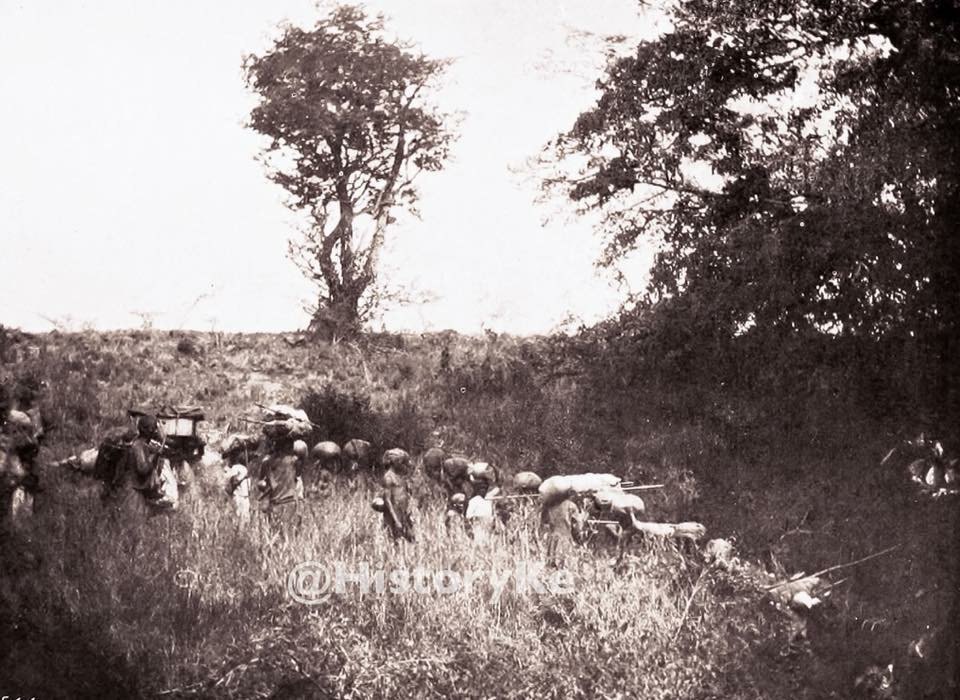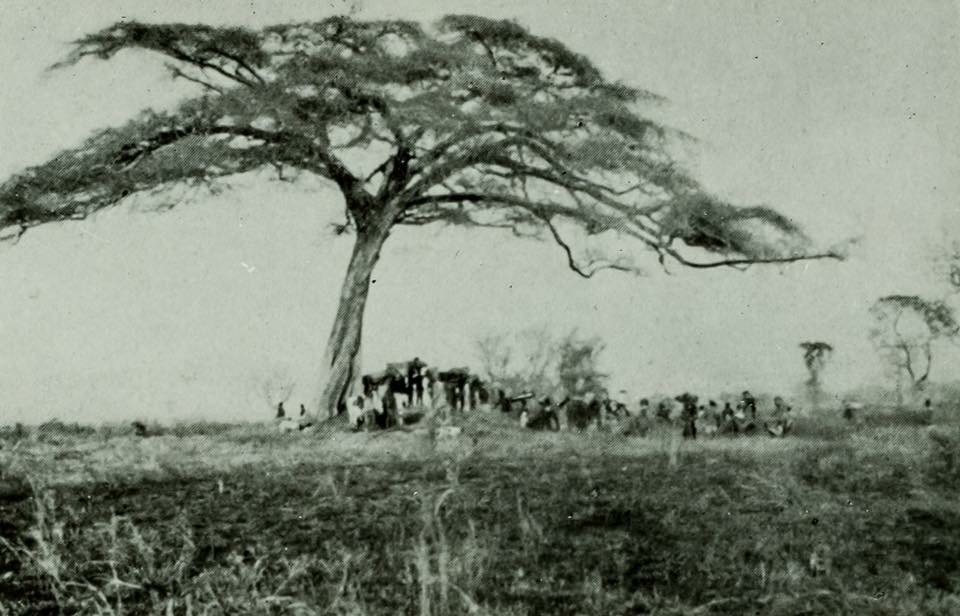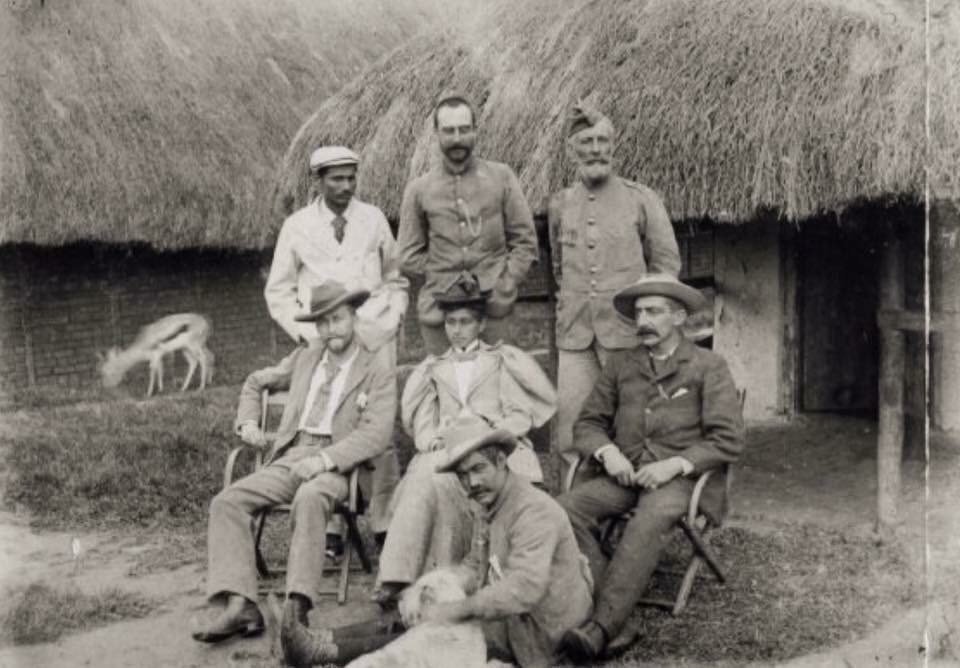2/ In November 1895, the acting commander of Fort Smith (Kikuyu), Thomas Gilkison, dispatched a food caravan of some 1,150 men to Ravine. The men were to replenish supplies needed by the advance railway survey team.
3/ The caravan consisted of about 1,000 Agïküyü porters and 150 swahilis, fifty of them armed with rifles. In those days, for a caravan of that size, a European was expected to be leader.
4/ But this caravan was different. Gilkison appointed a young Swahili man to be in-charge. The journey towards Nakuru was completed without incident. However, on the way back, there was an incident that took place at a Maasai manyatta that the caravan would later regret.
5/ On 25th November 1895, some members of the caravan stole milk from a Maasai manyatta at Kedong (present day Maï Mahiü area) and attempted to persuade a few Maasai women to accompany the caravan to their camp.
6/ It wasn& #39;t clear if the men committed these acts on their own or under instruction from the caravan leader.
7/ That evening, a senior Maasai elder visited the caravan& #39;s camp and warned the leader to control his men or there would be undesirable consequences.
8/ At daybreak, the caravan passed by the same manyatta. The caravan leader, betraying his stark ignorance of the Maasai, ordered for the seizure of some young Maasai girls for his pleasure. A few armed swahilis proceeded to enter the manyatta to execute their leader& #39;s orders.
9/ There are accounts that two Maasai girls were raped.
10/ In the commotion that ensued, a rifle of one of the Swahili guards loudly went off and from that instance, everything went south. The gunshot alerted adjoining manyattas, which quickly mobilized morans to go and investigate the commotion.
11/ At first light the following morning, the morans swooped on the caravan and speared or slashed anyone they could find. In the end, a total of 646 caravan members lay dead, among them 540 Agïküyü porters and about 100 Swahili including their armed askaris. The Maasai lost...
12/ ...no fewer than forty morans, although the figure was disputed by Andrew Dick, the Imperial British East Africa (IBEA) chief accountant.
13/ At the time of the massacre, Dick was camped a day& #39;s march away at Fort Smith, Kikuyu, and met survivors of the massacre who recounted their version of events.
14/ Instead of gathering facts of the incident from all parties involved, Dick strongly wanted to exact revenge on the Maasai. Gilkison sent him a sergeant with about thirty soldiers, who were however warned against proceeding to Kedong valley. Gilkison further sent him three...
15/ ...Frenchmen who had spent the night at Fort Smith and wanted to proceed further deeper into the interior.
16/ With the reluctant and largely non-combatant help of the Frenchmen, Dick captured 200 head of cattle and many sheep and donkeys. But in the act of driving off the livestock, Dick and his men became separated. The Maasai regrouped and attacked them from all sides.
17/ Dick is reported to have singlehandedly killed between forty and a hundred Maasai warriors before either running out of ammunition or suffering a weapon jam. It took a spear from a warrior reportedly called ole Lekutit to dispatch him.
18/ The Frenchmen witnessed Dick being speared to death but were unable to retrieve his body, instead opting to withdraw.
19/ Later that week, Lenana, the Laibon of the Maasai, sent emissaries to the Fort to announce his wish to make a ceremonial visit to Fort Smith. This was going to be his first meeting with a European official.
20/ Since word of the massacre had already reached the Fort, which also had Gïküyü assistants, Gilkison feared the Agîkûyû would overran it and seize or kill Lenana and his retinue of elders. He also feared that supplies of firewood and food from the local Agïküyü would cease.
21/ So ahead of Lenana& #39;s visit, Gilkison sent a runner to John Ainsworth, the sub commissioner at Machakos, to come over and help stage a quick investigation of what exactly happened at Kedong.
22/ In the subsequent meetings with the Laibon, his Maasai elders and Agïküyü elders, Ainsworth first persuaded the Laibon to disperse his warriors to their manyattas and to surrender the arms and property that were captured from the ill-fated caravan.
23/ He was then joined by Frederick Jackson from Ravine Fort and when the full story was known, they delivered a judgment that was in accordance with traditional principles of African justice, where all wrongs and grievances were settled by a fine of livestock determined by...
24/ ...the elders.
25/ Of course at the time, incarceration was not an option as it was a punitive concept that was alien to many African communities.
26/ In the classic & #39;Kedong Massacre& #39; judgement, the Maasai were not punished, either for the massacre or for the killing of Andrew Dick, on the grounds that the morans reacted to grave provocation. Yet, according to custom, the Agïküyü had to be compensated for the death of...
27/ ...their men and therefore the stolen Maasai livestock, which the Frenchmen had steadfastly driven to Fort Smith, were shared among the families of the dead Gïküyü porters and all parties were satisfied.
28/ Indeed, in a great show of empathy, Gïküyü elders conceded that the Maasai were not blameworthy.
29/ It sounds incredible today that a little over a century ago, a single incident at a small, perhaps unmarked, part of Kenya near Maï Mahiü soaked up the blood of over 600 individuals. That& #39;s an incident that even by today& #39;s standards, would have made major world headlines...
30/ ...then.

 Read on Twitter
Read on Twitter





